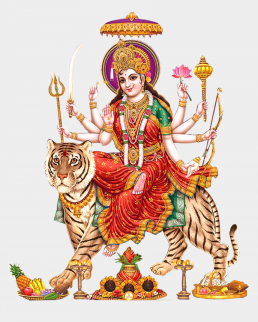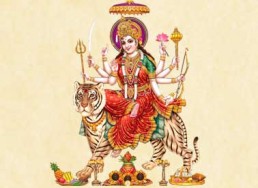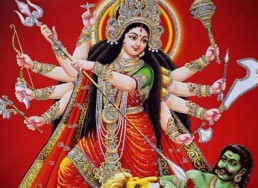Keelaka Stotram
विशुद्धज्ञानदेहाय त्रिवेदीदिव्यचक्षुषे ।
श्रेयः प्राप्तिनिमित्ताय नमः सोमार्धधारिणे ॥१॥
Viśuddha-Jnyāna-ḍehāya ṭri-Vedī-ḍivya-Cakssusse |
ṣreyah Prāpti-ṇimittāya ṇamah Soma-ārdha-ḍhārinne ||1||
to imbibe that auspiciousness (of pure knowledge). I meditate on Shiva and Shakti in their conscious blissful form. I offer my salutations to Shiva who bears the half-of-soma (soma means moon) and also to Shakti who bears half-of-soma (in her body as ardhanareeswara. Soma here is Shiva). Therefore, she has the same qualities of Shiva, of visuddha jnana deha and trivedi divya cakssu. Keelaka is pin or nail. The conscious form of Shakti is pinned to all the mantras of devi mahatmyam as the underlying principle through the keelaka stotram.
सोऽपि क्षेममवाप्नोति सततं जाप्यतत्परः ॥२॥
So-[ā]pi k͟hssemam-āvāpnoti Satatam Jāpya-ṭatparah ||2||
एतेन स्तुवतां देविं स्तोत्रवृन्देन भक्तितः ॥३॥
ĕtena Stuvatām ḍevim Stotra-Vrndena Bhaktitah ||3||
विना जप्येन सिद्धयेत्तु सर्वमुच्चाटनादिकम् ॥४॥
Vinā Japyena Siddhayet-ṭu Sarvam-ūccāttana-[ā]adikam ||4||
कृत्वा निमन्त्रयामास सर्वमेवमिदं शुभम् ॥५॥
k͟hrtvā ṇimantrayāmāsa Sarvam-ĕvam-īdam ṣubham ||5||
समाप्नोति स पुण्येन तां यथावन्निमन्त्रणाम् ॥६॥
Samāpnoti Sa Punnyena ṭām ẏathāvan-ṇimantrannām ||6||
कृष्णायां वा चतुर्दश्यामष्टम्यां वा समाहितः ॥७॥
k͟hrssnnāyām Vā Caturdaśyām-āssttamyām Vā Samāhitah ||7||
इत्थंरूपेण कीलेन महादेवेन कीलितम् ॥८॥
īttham-ṟūpenna k͟hīlena ṃahādevena k͟hīlitam ||8||
स सिद्धः स गणः सोऽथ गन्धर्वो जायते ध्रुवम् ॥९॥
Sa Siddhah Sa ġannah Sotha ġandharvo Jāyate ḍhruvam ||9||
नापमृत्युवशं याति मृते च मोक्षमाप्नुयात् ॥१०॥
ṇa-āpamrtyu-Vaśam ẏāti ṃrte Ca ṃokssam-āapnuyāt ||10||
ततो ज्ञात्वैव सम्पूर्णमिदं प्रारभ्यते बुधैः ॥११॥
ṭato Jnyātvai[ā-ĕ]va Sampūrnnam-īdam Prārabhyate Budhaih ||11||
तत्सर्वं तत्प्रसादेन तेन जप्यमिदं शुभम् ॥१२॥
ṭat-Sarvam ṭat-Prasādena ṭena Japyam-īdam ṣubham ||12||
भवत्येव समग्रापि ततः प्रारभ्यमेव तत् ॥१३॥
Bhavaty[i]-ĕva Samagra-āpi ṭatah Prārabhyam-ĕva ṭat ||13||
शत्रुहानिः परो मोक्षः स्तूयते सा न किं जनैः ॥१४॥
ṣatru-ḥānih Paro ṃokssah Stūyate Sā ṇa k͟him Janaih ||14||
हृद्यं काममवाप्नोति हृदि देवी सदा वसेत् ॥१५॥
ḥrdyam k͟hāmam-āvāpnoti ḥrdi ḍevī Sadā Vaset ||15||
निष्किलञ्च तथा कृत्वा पठितव्यं समाहितैः ॥१६॥
ṇisskilan.-Ca ṭathā k͟hrtvā Patthitavyam Samāhitaih ||16||

Description
Rishi Markandeya tells his disciples in sixteen shlokas the ways and means of removing obstacles faced by devotees while reading Devi Mahatmya. Reading of Keelakam brings blessings of Devi, spiritual harmony, peace of mind and success in all pursuits.
Other Durga Shlokams
Argala Stotram
Argala Stotram is the most famous prayer of Goddess Shakti (Durga) written by Markandeya Rishi. It has a twenty-six Verse. Before completing the Durga Saptasati (Devi Mahatmayam), in the first place,
Ayigiri Nandini
The Mahishasura Mardini Stotram also known popularly as Aigiri Nandini, holds immense significance during Navratri. The word Mahisha means buffalo and Asura means Rakshasa or Demon. Composed by the great sage Adi Shankaracharya around 810 AD, this…
Devi Aparadha Kshamapana Stotram
Composed by Sri Adi Shankaracharya. Aparadha Kshamapana stotram is usually recited after a recital or after the completion of Puja. Its like asking for forgiveness from Goddess for various mistakes th
Devi Suktam
Devi Suktam or the Vaak Sutam (Vak suktam) occurs in the 10th mandala of Rig Veda Samhita as suktam number 125. The seer of the mantra is vak, the daughter of rishi ambharnaa,
Durga Suktam
This is a prayer to the fire god Agni occurring in the Maha Narayana Upanishad. Section two. Agni, the Lord of Fire, symbolises the power of action.Goddess Durga symbolizes dynamism, energy, diligence
Kalika Ashtakam
Composed by Sri Adi Shankaracharya on devi Kalika. The Goddess Kali is the guardian, also known as Kalika. The protectors, the Mother, Kali is Dharma and eternal time. Kali shines with the brilliance
Mahishasura Mardini Storam
Mahishasura Mardini Stotram - This is a prayer to the Goddess who killed Mahishasura. “The place where Sri Mahishasura Mardini Stotram is sung every day, I will always be present and never leave.” - The Devi’s proclamation in the 12th chapter of the…
Sarva Mangala Mangalye
Sarva Mangala Mangalye - Salutations to you O Narayani, who is the auspiciousness of all that is auspicious, the consort of Lord Shiva, who is the means of accomplishing all desires, and who is the refuge of all, the consort of the three eyed Shiva,…
Shakradaya Stuti
This famous stuti is sung by Shakra (Indra) and the other devas in praise of Durga. This is part of Chandi path which is a text about Goddess Chandi. It is also called Durga Saptashati or 700 verses r
Tantrokta Ratri Suktam
Ratri Sukta is one of the famous hymn to Goddess Durga. This in true essence praises the latent energy in Narayana and in every sadhak. Ratri Suktam is used to invoke that energy and to enhance the mi
Keelaka Stotram – Durga – In Sanskrit with English Transliteration, Translation and Meaning. Commentary for selected Shlokams.


